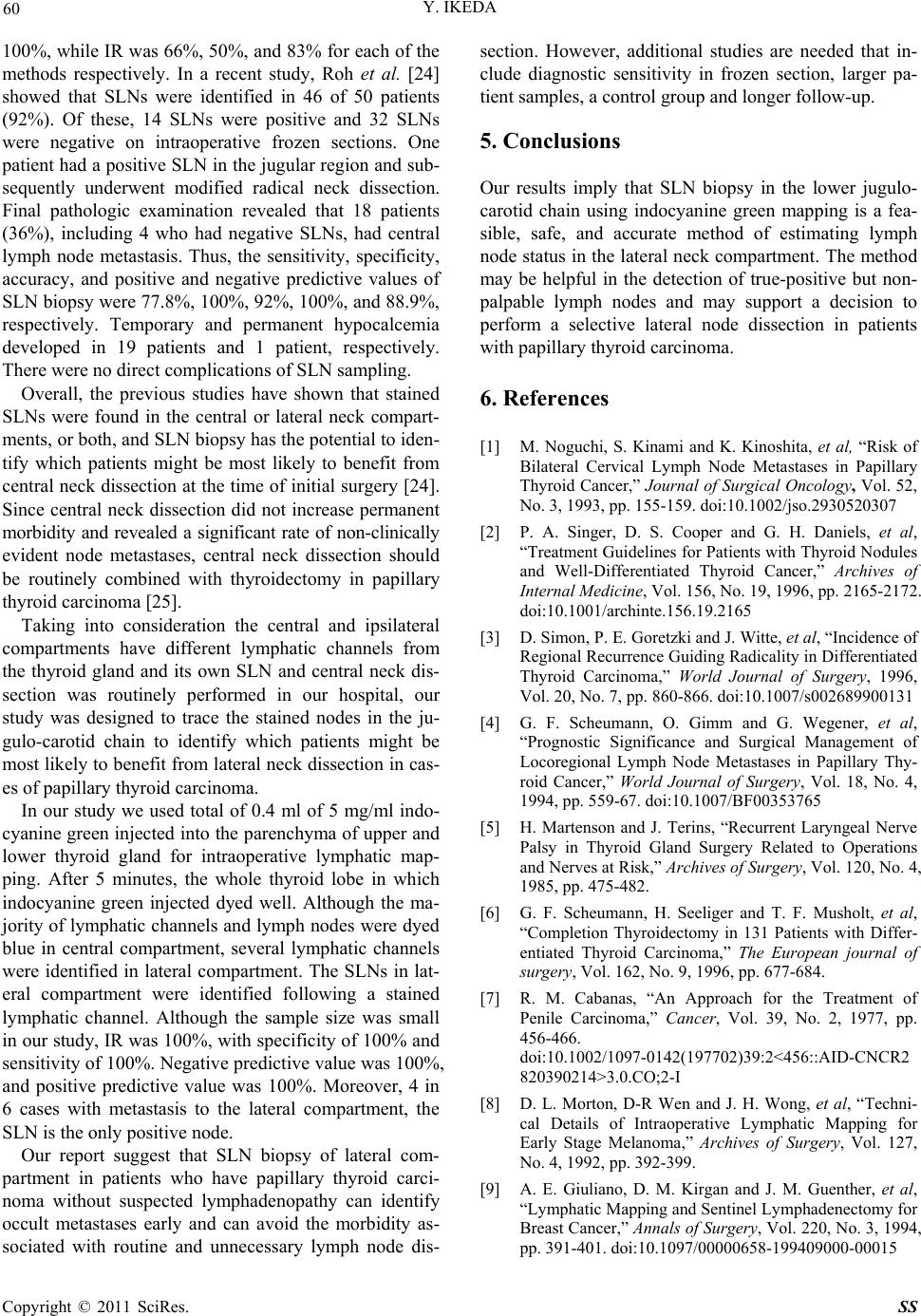
60 Y. IKEDA
100%, while IR was 66%, 50%, and 83% for each of th e
methods respectively. In a recent study, Roh et al. [24]
showed that SLNs were identified in 46 of 50 patients
(92%). Of these, 14 SLNs were positive and 32 SLNs
were negative on intraoperative frozen sections. One
patient had a positive SLN in the jug ular region and sub-
sequently underwent modified radical neck dissection.
Final pathologic examination revealed that 18 patients
(36%), including 4 who had negative SLNs, had central
lymph node metastasis. Thus, the sensitivity, specificity,
accuracy, and positive and negative predictive values of
SLN biopsy were 77.8%, 100%, 92%, 100%, and 88.9%,
respectively. Temporary and permanent hypocalcemia
developed in 19 patients and 1 patient, respectively.
There were no di rect c omplications of SL N s ampling.
Overall, the previous studies have shown that stained
SLNs were found in the central or lateral neck compart-
ments, or both, and SLN biopsy has the potential to iden-
tify which patients might be most likely to benefit from
central neck dissection at the time of initial surgery [2 4].
Since central neck dissection did not increase permanent
morbidity and revealed a significant rate of non-clinically
evident node metastases, central neck dissection should
be routinely combined with thyroidectomy in papillary
thyroid carcinoma [25].
Taking into consideration the central and ipsilateral
compartments have different lymphatic channels from
the thyroid gland and its own SLN and central neck dis-
section was routinely performed in our hospital, our
study was designed to trace the stained nodes in the ju-
gulo-carotid chain to identify which patients might be
most likely to ben efit from lateral neck dissection in cas-
es of papillary thyroid carcinoma.
In our study we used total of 0.4 ml of 5 mg/ml indo-
cyanine green injected into the parenchyma of upper and
lower thyroid gland for intraoperative lymphatic map-
ping. After 5 minutes, the whole thyroid lobe in which
indocyanine green injected dyed well. Although the ma-
jority of lymphatic channels an d lymph nodes were dyed
blue in central compartment, several lymphatic channels
were identified in lateral compartment. The SLNs in lat-
eral compartment were identified following a stained
lymphatic channel. Although the sample size was small
in our study, IR was 100 %, with specificity of 100% and
sensitivity of 100%. Negativ e pred ictive value was 100 %,
and positive predictive value was 100%. Moreover, 4 in
6 cases with metastasis to the lateral compartment, the
SLN is the only positive nod e.
Our report suggest that SLN biopsy of lateral com-
partment in patients who have papillary thyroid carci-
noma without suspected lymphadenopathy can identify
occult metastases early and can avoid the morbidity as-
sociated with routine and unnecessary lymph node dis-
section. However, additional studies are needed that in-
clude diagnostic sensitivity in frozen section, larger pa-
tient samples, a control group and longer follow-up.
5. Conclusions
Our results imply that SLN biopsy in the lower jugulo-
carotid chain using indocyanine green mapping is a fea-
sible, safe, and accurate method of estimating lymph
node status in the lateral neck compartment. The method
may be helpful in the detection of true-positive but non-
palpable lymph nodes and may support a decision to
perform a selective lateral node dissection in patients
with papillary thyroid carcinoma.
6. References
[1] M. Noguchi, S. Kinami and K. Kinoshita, et al, “Risk of
Bilateral Cervical Lymph Node Metastases in Papillary
Thyr oid Cancer,” Journal of Surgical Oncology, Vol. 52,
No. 3, 1993, pp. 155-159. doi:10.1002/jso.2930520307
[2] P. A. Singer, D. S. Cooper and G. H. Daniels, et al,
“Treatment Guidelines for Patients with Thyroid Nodules
and Well-Differentiated Thyroid Cancer,” Archives of
Internal Medicine, Vol. 156, No. 19, 1996, pp. 2165-2172.
doi:10.1001/archinte.156.19.2165
[3] D. Simon, P. E. Goretzki and J. Witte, et al, “Incidence of
Regional Recurrence Guiding Radicality in Differentiated
Thyroid Carcinoma,” World Journal of Surgery, 1996,
Vol. 20, No. 7, pp. 860-866. doi:10.1007/s002689900131
[4] G. F. Scheumann, O. Gimm and G. Wegener, et al,
“Prognostic Significance and Surgical Management of
Locoregional Lymph Node Metastases in Papillary Thy-
roid Cancer,” World Journal of Surgery, Vol. 18, No. 4,
1994, pp. 559-67. doi:10.1007/BF00353765
[5] H. Martenson and J. Terins, “Recurrent Laryngeal Nerve
Palsy in Thyroid Gland Surgery Related to Operations
and Nerves at Risk,” Archives of Surgery, Vol. 120, No. 4,
1985, pp. 475-482.
[6] G. F. Scheumann, H. Seeliger and T. F. Musholt, et al,
“Completion Thyroidectomy in 131 Patients with Differ-
entiated Thyroid Carcinoma,” The European journal of
surgery, Vol. 162, No. 9, 1996, pp. 677-684.
[7] R. M. Cabanas, “An Approach for the Treatment of
Penile Carcinoma,” Cancer, Vol. 39, No. 2, 1977, pp.
456-466.
doi:10.1002/1097-0142(197702)39:2<456::AID-CNCR2
820390214>3.0.CO;2-I
[8] D. L. Morton, D-R Wen and J. H. Wong, et al, “Techni-
cal Details of Intraoperative Lymphatic Mapping for
Early Stage Melanoma,” Archives of Surgery, Vol. 127,
No. 4, 1992, pp. 392-399.
[9] A. E. Giuliano, D. M. Kirgan and J. M. Guenther, et al,
“Lymphatic Mapping and Sentinel Lymphadenectomy for
Breast Cancer,” Annals of Surgery, Vol. 220, No. 3, 1994,
pp. 391-401. doi:10.1097/00000658-199409000-00015
Copyright © 2011 SciRes. SS